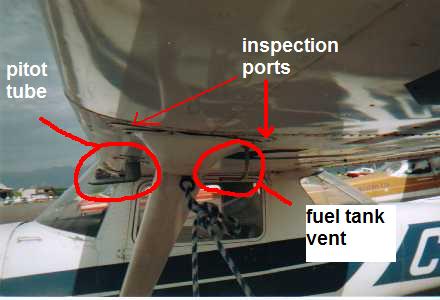|
Air Vents
 In a Cessna, there are cabin vents at the
top corners of the windscreen. From the cockpit, the pilot or front seat passenger
can pull and turn a tube to control how much fresh air enters the cabin.
On the outside of the airplane, at the wing roots, you can see the vent opening
on your preflight inspection. The right side vent also incorporates an outside
air temperature probe (aviation speak for "thermometer"). You can read
the indicated OAT on a dial at the end of the vent control. In a Cessna, there are cabin vents at the
top corners of the windscreen. From the cockpit, the pilot or front seat passenger
can pull and turn a tube to control how much fresh air enters the cabin.
On the outside of the airplane, at the wing roots, you can see the vent opening
on your preflight inspection. The right side vent also incorporates an outside
air temperature probe (aviation speak for "thermometer"). You can read
the indicated OAT on a dial at the end of the vent control.
The other opening in the leading edge of the Cessna wing is the opening for
the stall horn. As the angle of attack of the wing increases,
the center of pressure -- actually a low pressure area -- moves forward. When
it has moved far forward the wing is close to stalling, and the pressure
above the stall horn opening is low enough that air is being sucked
out through the opening. That forces air through the stall horn
reed and makes a sound like a kazoo - the stall warning.
In a Piper, the stall warning is activated when low pressure pulls up on a
small protruding tab of metal. The movement of the tab closes an electrical
contact and triggers a stall warning light in the cockpit.
 Also marked in the top picture on this page is
a VHF radio antenna, and a fairing designed to reduce interference
drag between the main gear strut and the fusilage. Also marked in the top picture on this page is
a VHF radio antenna, and a fairing designed to reduce interference
drag between the main gear strut and the fusilage.
The second picture shows the right side of a Cessna 150. Notice the little
vent door that is open in the lower blue stripe. That
door is controlled by the cabin air knob on the dashboard. Pull it out to
open the door and bring fresh air into the cockpit. Make sure it's closed
all the way on a cold day.
This picture shows a few other items, but not very clearly. There is a hydraulic
line emerging from the fusilage: it runs down the main gear inside the
fairing to provide the hydraulic pressure that activates the brake. You can
also see the mechanical steering linkage from the right rudder pedal
to the nosewheel, and a tiny little stick which is this airplane's transponder
antenna.
 The bottom picture zooms in on two
similar looking parts with very different functions. The pitot tube
projects forward into the airstream and the air pressure there is compared
agains the air pressure at the static port in order to determine the airspeed. The bottom picture zooms in on two
similar looking parts with very different functions. The pitot tube
projects forward into the airstream and the air pressure there is compared
agains the air pressure at the static port in order to determine the airspeed.
In a Cessna, the static port is on the left side of the airplane just forward
of the wing strut. On a Piper it is incorporated into the pitot tube.
The fuel tank vent is behind the wing strut, to keep it out of the air flow.
The vent goes up to almost the top of the tank. You will see fule dripping
out of it when the fuel tank is very full, but it has a function more important
than an overflow. As fuel drains from the tanks into the engine, something
must replace the volume of the fuel, or a vacuum would form, preventing more
fuel from leaving the tanks. The fuel tank vent allows air to enter
the tank. It's a bit like punching a two holes in a can of tomato juice
in order to get it to pour without glugging.
Speaking of holes, there are holes all over the airplane designed to allow
your mechanics to inspect or access different potential trouble spots on your
aircraft. You can recognize them by the round covers, held on by a
few screws.
This page written 10 November 2003 by Robyn Stewart.
Copyright 2003 Flying Start
Initiatives
|
Robyn's Flying Start Home

Flight Training
Overview of flight training
Air
Intakes
Carb heat, engine air and where it goes
Vents
Cabin air, overhead vents and OAT
Trims
Aileron trim, rudder trim and elevator trim
Antennae
Comm, VOR, ADF & ELT
Gear
Tricycle & conventional
Search
Search all of wabyn.net
Contact
Robyn
Send me e-mail
|